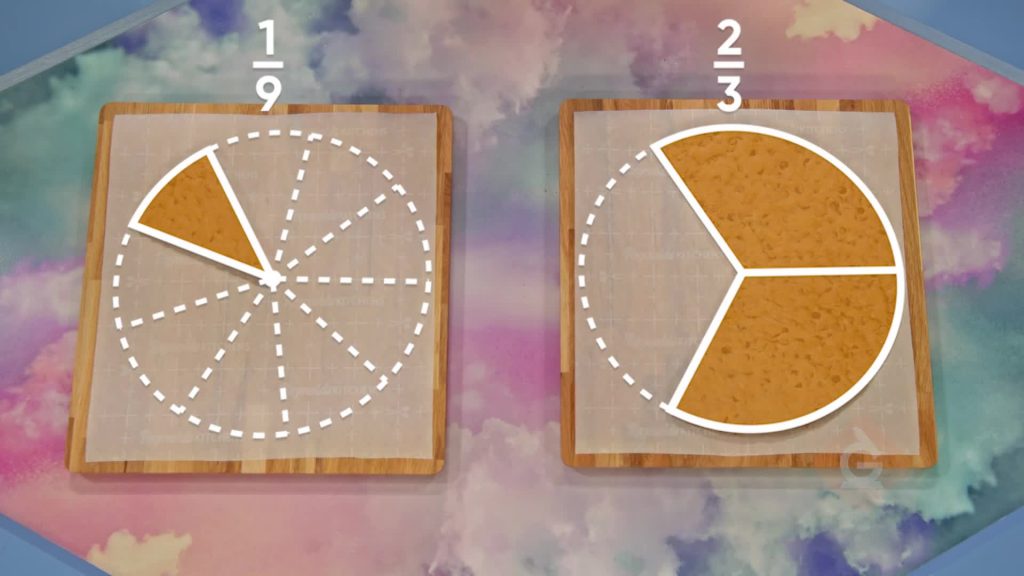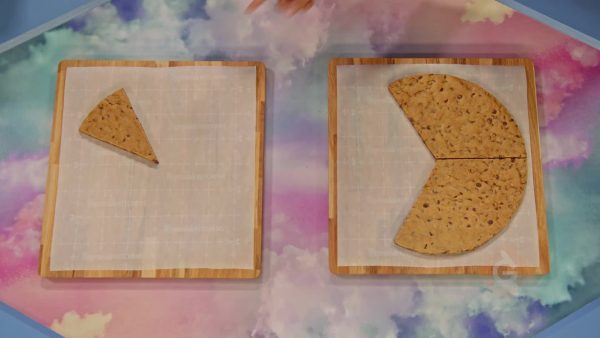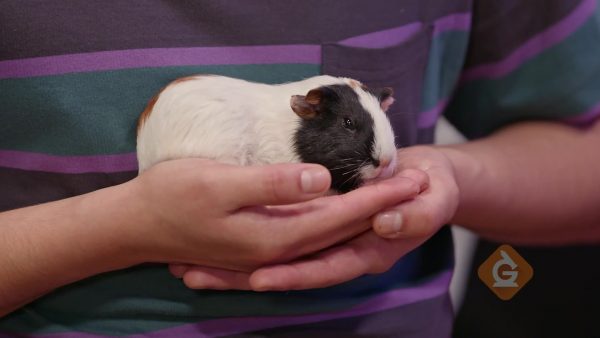
Two fractions have unlike denominators if the numbers in the denominators are not the same. You can use multiplication and division to rewrite fractions to have a common denominator.
To better understand adding and subtracting fractions with unlike denominators…
LET’S BREAK IT DOWN!
Cookies

Let's say that Marcos and April each have a large cookie. They each ate part of their cookie. Marcos has [ggfrac]1/9[/ggfrac] of his cookie left and April has [ggfrac]2/3[/ggfrac] of hers left. How much cookie do they have left, combined? To answer this question, you need to rewrite the fractions with a common denominator by finding equivalent fractions, and then add. Start with the fraction with the smaller denominator, [ggfrac]2/3[/ggfrac]. We can find an equivalent fraction by multiplying both the numerator and denominator by the same number. Multiply [ggfrac]2/3[/ggfrac] by [ggfrac]3/3[/ggfrac] to find an equivalent fraction with denominator 9. [ggfrac]2/3[/ggfrac] x [ggfrac]3/3[/ggfrac] = [ggfrac]6/9[/ggfrac].[ggfrac]6/9[/ggfrac] has the same denominator as [ggfrac]1/9[/ggfrac] and is equivalent to [ggfrac]2/3[/ggfrac]. Now we can rewrite the original addition as [ggfrac]1/9[/ggfrac] + [ggfrac]6/9[/ggfrac] = [ggfrac]7/9[/ggfrac]. They have [ggfrac]7/9[/ggfrac] of a cookie left. Try this one yourself. You ate [ggfrac]2/5[/ggfrac] of a pizza and your sister ate [ggfrac]1/10[/ggfrac] of the same pizza. How much of the pizza did you eat in all?
Algorithm for Finding a Common Denominator

Let's say you want to add [ggfrac]1/3[/ggfrac] + [ggfrac]2/5[/ggfrac]. You know that you need to find a common denominator. Starting with [ggfrac]1/3[/ggfrac], list equivalent fractions: [ggfrac]1/3[/ggfrac] x [ggfrac]2/2[/ggfrac] = [ggfrac]2/6[/ggfrac], [ggfrac]1/3[/ggfrac] x [ggfrac]3/3[/ggfrac] = [ggfrac]3/9[/ggfrac], [ggfrac]1/3[/ggfrac] x [ggfrac]4/4[/ggfrac] = [ggfrac]4/12[/ggfrac], [ggfrac]1/3[/ggfrac] x [ggfrac]5/5[/ggfrac] = [ggfrac]5/15[/ggfrac], and [ggfrac]1/3[/ggfrac] x [ggfrac]6/6[/ggfrac] = [ggfrac]6/18[/ggfrac]. None of those fractions have a denominator of 5, so you need to find equivalent fractions for [ggfrac]2/5[/ggfrac] as well: [ggfrac]2/5[/ggfrac] x [ggfrac]2/2[/ggfrac] = [ggfrac]4/10[/ggfrac], [ggfrac]2/5[/ggfrac] x [ggfrac]3/3[/ggfrac] = [ggfrac]6/15[/ggfrac], and [ggfrac]2/5[/ggfrac] x [ggfrac]4/4[/ggfrac] = [ggfrac]8/20[/ggfrac]. Both [ggfrac]1/3[/ggfrac] and [ggfrac]2/5[/ggfrac] have an equivalent fraction with a denominator of 15. Rewrite the original addition as [ggfrac]5/15[/ggfrac] + [ggfrac]6/15[/ggfrac] = [ggfrac]11/15[/ggfrac].
There is a faster way to find a common denominator. If you multiply the numerator and the denominator of each fraction by the denominator of the other fraction, you always get fractions with a common denominator. Here's how this works: Starting with [ggfrac]1/3[/ggfrac], you see that the other fraction, [ggfrac]2/5[/ggfrac], has a denominator of 5 so you multiply the numerator and denominator by 5: [ggfrac]1/3[/ggfrac] x [ggfrac]5/5[/ggfrac] = [ggfrac]5/15[/ggfrac]. Next, you see that [ggfrac]1/3[/ggfrac] has a denominator of 3, so you multiply the numerator and denominator of the other fraction by 3: [ggfrac]2/5[/ggfrac] x [ggfrac]3/3[/ggfrac] = [ggfrac]6/15[/ggfrac]. Rewrite the original addition as [ggfrac]5/15[/ggfrac] + [ggfrac]6/15[/ggfrac] = [ggfrac]11/15[/ggfrac]. Try this one yourself. Add [ggfrac]1/6[/ggfrac] + [ggfrac]3/4[/ggfrac] by finding a common denominator using the faster way.
Guinea Pig Weights

Let's say that you have two tiny guinea pigs. One weighs [ggfrac]4/5[/ggfrac] of a pound and the other weighs [ggfrac]2/3[/ggfrac] of a pound. You want to figure out how much more one guinea pig weighs than the other. You can find this difference using the equation [ggfrac]4/5[/ggfrac] - [ggfrac]2/3[/ggfrac] = ?. First, find the equivalent fractions that have a common denominator. The second fraction has a denominator of 3, so multiply the numerator and denominator of the first fraction by 3. [ggfrac]4/5[/ggfrac] x [ggfrac]3/3[/ggfrac] = [ggfrac]12/15[/ggfrac]. Next, multiply [ggfrac]2/3[/ggfrac] x [ggfrac]5/5[/ggfrac] since 5 is the denominator of [ggfrac]4/5[/ggfrac]. [ggfrac]2/3[/ggfrac] x [ggfrac]5/5[/ggfrac] = [ggfrac]10/15[/ggfrac]. Rewrite the original subtraction [ggfrac]4/5[/ggfrac] - [ggfrac]2/3[/ggfrac] as [ggfrac]12/15[/ggfrac] - [ggfrac]10/15[/ggfrac] = [ggfrac]2/15[/ggfrac]. One guinea pig weighs [ggfrac]2/15[/ggfrac] of a pound more than the other guinea pig. Try this one yourself. My bag of candy weighs [ggfrac]3/4[/ggfrac] of a pound and my friend's bag of candy weighs [ggfrac]2/3[/ggfrac] of a pound. How much more does my bag of candy weigh?
Rollerblading and Long Jumping

Let's say that you rollerbladed 2[ggfrac]3/4[/ggfrac] miles yesterday and 3[ggfrac]1/3[/ggfrac] miles today. How many total miles did you rollerblade? To answer this, solve 2[ggfrac]3/4[/ggfrac] + 3[ggfrac]1/3[/ggfrac]. You can add fractions and whole numbers separately and combine the answers. Let's start with the fractions and add [ggfrac]3/4[/ggfrac] + [ggfrac]1/3[/ggfrac]. They have unlike denominators, so multiply each fraction's numerator and denominator by the other fraction's denominator to get equivalent fractions: [ggfrac]3/4[/ggfrac] x [ggfrac]3/3[/ggfrac] = [ggfrac]9/12[/ggfrac] and [ggfrac]1/3[/ggfrac] x [ggfrac]4/4[/ggfrac] = [ggfrac]4/12[/ggfrac]. Add the new numerators. [ggfrac]9/12[/ggfrac]+ [ggfrac]4/12[/ggfrac] = [ggfrac]13/12[/ggfrac]. Since this fraction is greater than 1, regroup from an improper fraction to a mixed number: [ggfrac]13/12[/ggfrac] = [ggfrac]12/12[/ggfrac] + [ggfrac]1/12[/ggfrac] = 1[ggfrac]1/12[/ggfrac]. Next, add the whole numbers: 2 + 3 = 5. Then combine the totals: 5 + 1[ggfrac]1/12[/ggfrac] = 6[ggfrac]1/12[/ggfrac]. You rollerbladed a total of 6[ggfrac]1/12[/ggfrac] miles.
Let's look at an example of subtracting mixed numbers. Let's say Marcos had a long jump of 5[ggfrac]1/6[/ggfrac] feet and April jumped 4[ggfrac]2/3[/ggfrac] feet. We can figure out how much farther Marcos jumped by solving 5[ggfrac]1/6[/ggfrac] - 4[ggfrac]2/3[/ggfrac] = ?. Start by finding [ggfrac]1/6[/ggfrac] - [ggfrac]2/3[/ggfrac]. The denominators are unlike, so we need to find equivalent fractions with a common denominator: 2 x 3 = 6, so multiply the numerator and denominator of [ggfrac]2/3[/ggfrac] by 2: [ggfrac]2/3[/ggfrac] x [ggfrac]2/2[/ggfrac] = [ggfrac]4/6[/ggfrac]. The fraction subtraction is now [ggfrac]1/6[/ggfrac] - [ggfrac]4/6[/ggfrac]. 4 is greater than 1, so we need to regroup from 5 to make a fraction greater than [ggfrac]4/6[/ggfrac]. Regroup 1 one into 6 sixths. 5 = 4[ggfrac]6/6[/ggfrac]. Add the new sixths to [ggfrac]1/6[/ggfrac]. [ggfrac]6/6[/ggfrac] + [ggfrac]1/6[/ggfrac] = [ggfrac]7/6[/ggfrac]. Now we can subtract the fractions: [ggfrac]7/6[/ggfrac] - [ggfrac]4/6[/ggfrac] = [ggfrac]3/6[/ggfrac]. Finally, subtract the remaining whole number parts of the mixed numbers: 4 - 4 = 0. Marcos jumped [ggfrac]3/6[/ggfrac] of a foot farther than April. Try this one yourself. I hiked 6[ggfrac]1/8[/ggfrac] miles on Saturday and another 4[ggfrac]2/3[/ggfrac] miles on Sunday. How many total miles did I hike this weekend?
ADD AND SUBTRACT FRACTIONS (UNLIKE DENOMINATORS) VOCABULARY
ADD AND SUBTRACT FRACTIONS (UNLIKE DENOMINATORS) DISCUSSION QUESTIONS
Which part of a fraction tells you the number of equal-sized parts that the whole is broken into?
What is the meaning of the numerator when adding or subtracting fractions?
How can we find equivalent fractions with a common denominator for two fractions with unlike denominators?
Which of the following benchmark numbers—0, [ggfrac]1/2[/ggfrac], or 1—can you use to help estimate when adding [ggfrac]4/9[/ggfrac] to another fraction?
Rafay says that 5 - 3[ggfrac]1/3[/ggfrac] = 2[ggfrac]1/3[/ggfrac]. Is Rafay correct? If not, what did Rafay do wrong?
Skip, I will use a 3 day free trial
Enjoy your free 30 days trial
We use cookies to make your experience with this site better. By using this site you agree to our use of cookies. Click "Decline" to delete and block any non-essential cookies for this site on this specific property, device, and browser. Please read our privacy policy for more information on the cookies we use.Learn More
We use cookies to improve your experience. By using this site, you agree to our use of cookies. Click "Decline" to block non-essential cookies. See our privacy policy for details.Learn More






